
A | B | C | D | E | F | G | H | CH | I | J | K | L | M | N | O | P | Q | R | S | T | U | V | W | X | Y | Z | 0 | 1 | 2 | 3 | 4 | 5 | 6 | 7 | 8 | 9
| Drongo | |
|---|---|

| |
| Hair-crested drongo (D. hottentottus striatus) | |
| Scientific classification | |
| Domain: | Eukaryota |
| Kingdom: | Animalia |
| Phylum: | Chordata |
| Class: | Aves |
| Order: | Passeriformes |
| Superfamily: | Corvoidea |
| Family: | Dicruridae Vigors, 1825 |
| Genus: | Dicrurus Vieillot, 1816 |
| Type species | |
| Corvus balicassius (Balicassiao) Linnaeus, 1766
| |
| Dicrurus phylogeny | |||||||||||||||||||||||||||||||||||||||||||||||||||||||||||||||||||||||||||||||||||||||||||||||||||||||||
| |||||||||||||||||||||||||||||||||||||||||||||||||||||||||||||||||||||||||||||||||||||||||||||||||||||||||
| Cladogram based on a study by Eric Pasquet and colleagues published in 2007.[1] |
The drongos are a family, Dicruridae, of passerine birds of the Old World tropics. The 31 species in the family are placed in a single genus, Dicrurus.
Drongos are mostly black or dark grey, short-legged birds, with an upright stance when perched. They have forked tails and some have elaborate tail decorations. They feed on insects and small birds, which they catch in flight or on the ground. Some species are accomplished mimics and have a variety of alarm calls, to which other birds and animals often respond. They are known to utter fake alarm calls that scare other animals off food, which the drongo then claims.
Taxonomy
The genus Dicrurus was introduced by French ornithologist Louis Pierre Vieillot for the drongos in 1816.[2] The type species was subsequently designated as the balicassiao (Dicrurus balicassius) by English zoologist George Robert Gray in 1841.[3][4] The name of the genus combines the Ancient Greek words dikros "forked" and oura "tail".[5] "Drongo" is originally from the indigenous language of Madagascar, where it refers to the crested drongo; it is now used for all members of the family.[6]
This family now includes only the genus Dicrurus, although Christidis and Boles (2007) expanded the family to include the subfamilies Rhipidurinae (Australasian fantails), Monarchinae (monarch and paradise flycatchers), and Grallininae (magpie larks).[7]
The family was formerly treated as having two genera, Chaetorhynchus and Dicrurus. The genus Chaetorhynchus contains a single species, the New Guinea-endemic C. papuensis. On the basis of both morphological and genetic differences, it is now placed with the fantails (Rhipiduridae) and renamed from the pygmy drongo to the drongo fantail.[8]
The genus Dicrurus contains 28 species:[9]
| Image | Common Name | Scientific name | Distribution |
|---|---|---|---|
 |
Square-tailed drongo | Dicrurus ludwigii | southern Africa. |
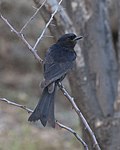 |
Sharpe's drongo | Dicrurus sharpei | southern South Sudan and western Kenya to the Democratic Republic of the Congo to Nigeria |
 |
Shining drongo | Dicrurus atripennis | Cameroon, Central African Republic, Republic of the Congo, Democratic Republic of the Congo, Ivory Coast, Equatorial Guinea, Gabon, Ghana, Guinea, Liberia, Nigeria, Sierra Leone, and Togo. |
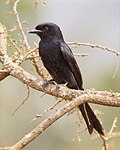 |
Fork-tailed drongo | Dicrurus adsimilis | Gabon, Congo Republic, DRC, Angola, northwestern Zambia, Namibia, Botswana and northwestern South Africa |
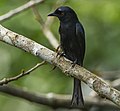 |
Velvet-mantled drongo | Dicrurus modestus | Nigeria and Cameroon to the Democratic Republic of Congo and Angola. |
| Grande Comore drongo | Dicrurus fuscipennis | Comoros. | |
 |
Aldabra drongo | Dicrurus aldabranus | Seychelles |
 |
Crested drongo | Dicrurus forficatus | Madagascar and Comoros |
| Mayotte drongo | Dicrurus waldenii | Mayotte. | |
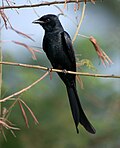 |
Black drongo | Dicrurus macrocercus | Iran through Pakistan, India, Bangladesh and Sri Lanka east to southern China and Indonesia and accidental visitor of Japan |
 |
Ashy drongo | Dicrurus leucophaeus | eastern Afghanistan east to southern China, Ryukyu Islands in southern Japan (particularly Okinawa) and Indonesia. |
 |
White-bellied drongo | Dicrurus caerulescens | India and Sri Lanka. |
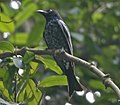 |
Crow-billed drongo | Dicrurus annectens | Bangladesh, Bhutan, Brunei, Cambodia, China, India, Indonesia, Laos, Malaysia, Myanmar, Nepal, Philippines, Singapore, Thailand, and Vietnam. |
 |
Bronzed drongo | Dicrurus aeneus | western Uttaranchal eastwards into Indochina and Hainan, the Malay Peninsula, Sumatra and northern Borneo |
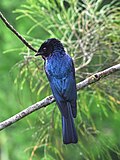 |
Lesser racket-tailed drongo | Dicrurus remifer | Bangladesh, Bhutan, Cambodia, India, Indonesia, Laos, Malaysia, Myanmar, Nepal, Thailand, and Vietnam. |
 |
Balicassiao | Dicrurus balicassius | Philippines. |
| Short-tailed drongo | Dicrurus striatus | Philippines. | |
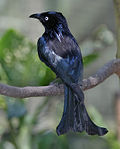 |
Hair-crested drongo | Dicrurus hottentottus | Bangladesh, India, and Bhutan through Indochina to China, Indonesia, and Brunei. |
| Tablas drongo | Dicrurus menagei | Philippines. | |
| Palawan drongo | Dicrurus palawanensis | Palawan. | |
| Sumatran drongo | Dicrurus sumatranus | Sumatra in Indonesia. | |
 |
Wallacean drongo | Dicrurus densus | Indonesia and East Timor. |
 |
Sulawesi drongo | Dicrurus montanus | Sulawesi in Indonesia. |
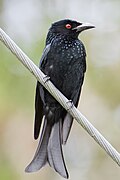 |
Spangled drongo | Dicrurus bracteatus | Australia, New Guinea, Indonesia |
